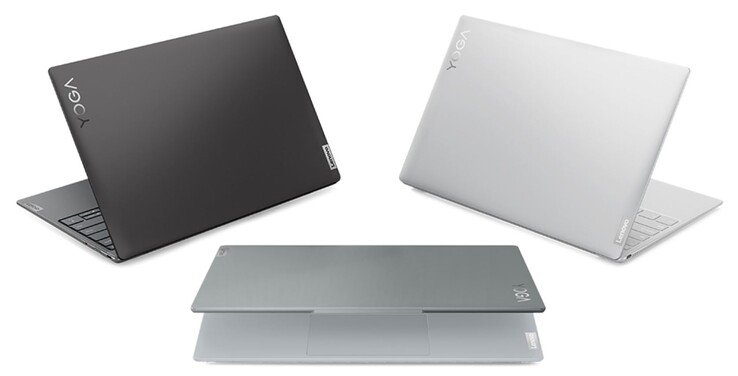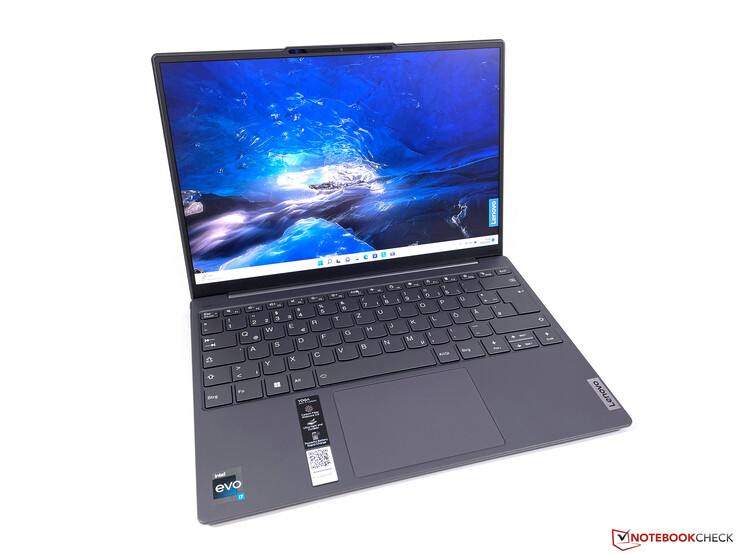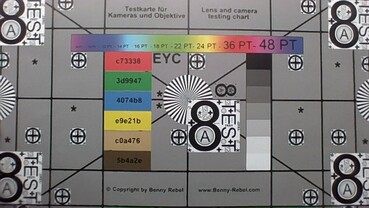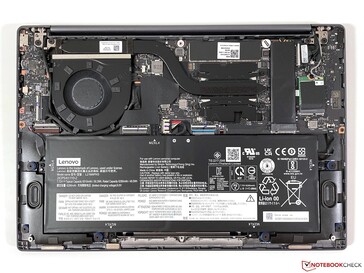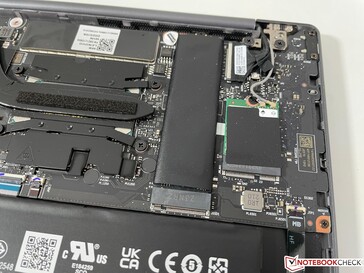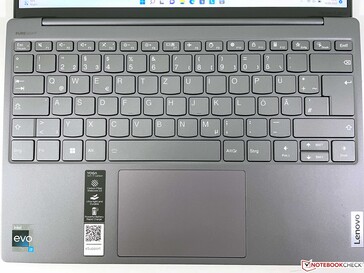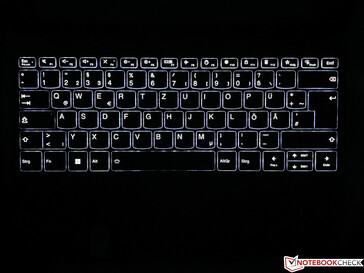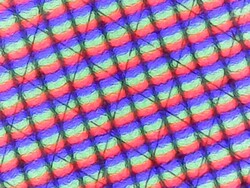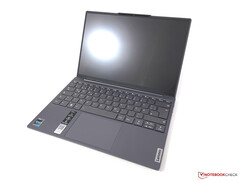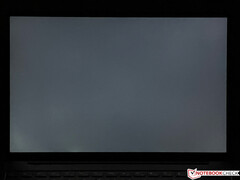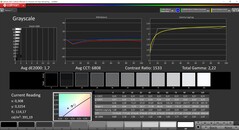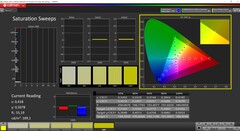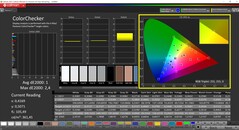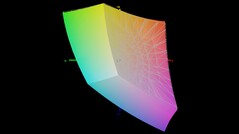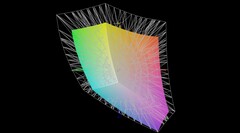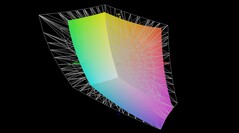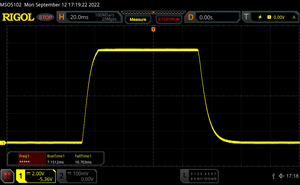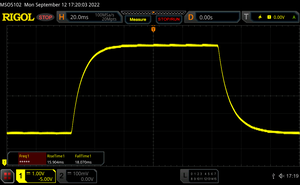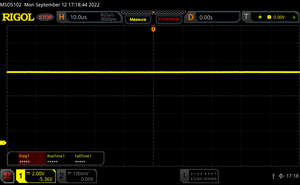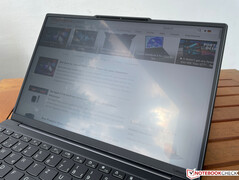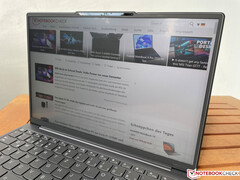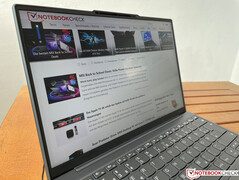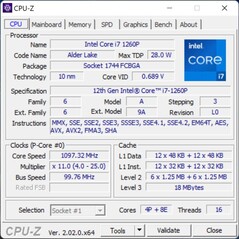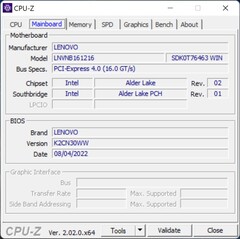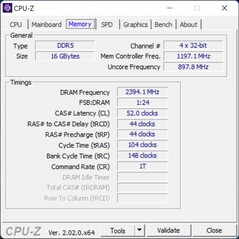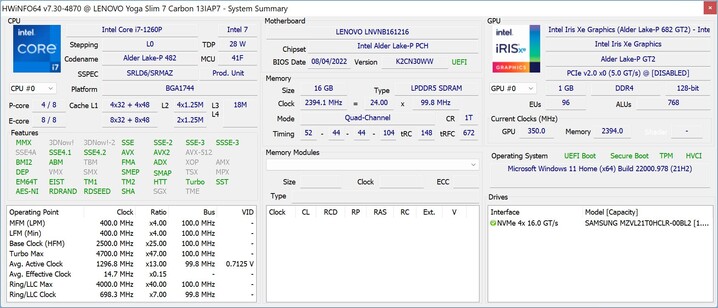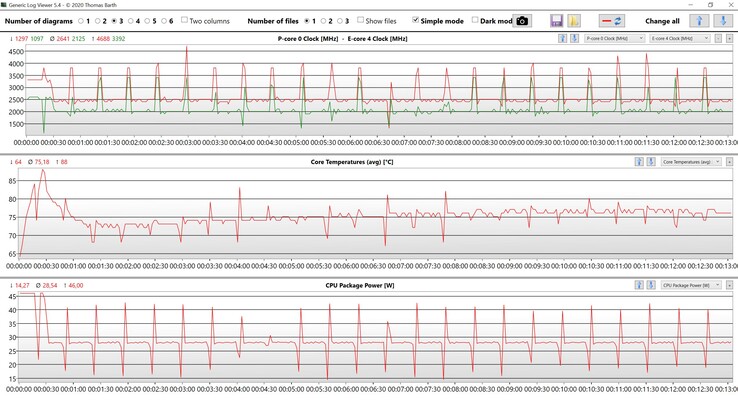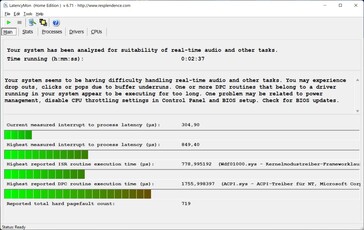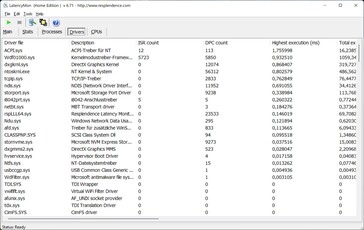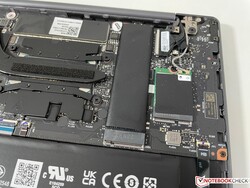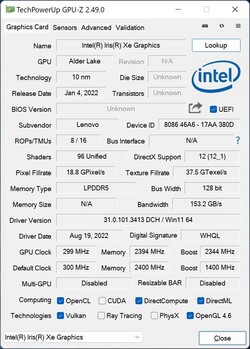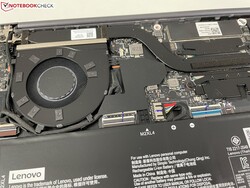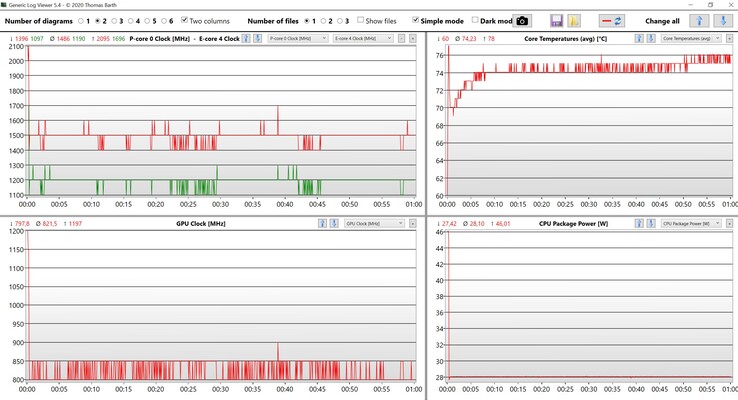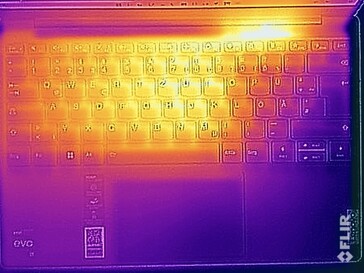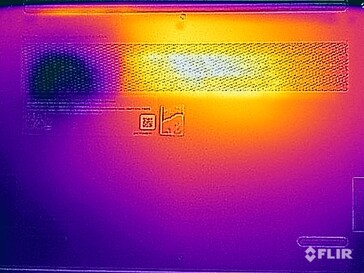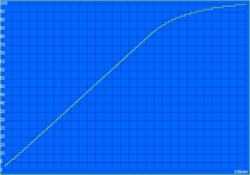Recensione del portatile Lenovo Yoga Slim 7i Carbon 13 - potente ultraportatile sotto il peso di 1 kg

Lenovo offre da anni lo Yoga Slim 7i Carbon 13, un portatile ultraportatile da 13 pollici. Il produttore ha dotato l'ultimo dispositivo di settima generazione di un nuovo chassis, di un nuovo display 16:10 e di processori Intel di dodicesima generazione. Il portatile è dotato anche dei più veloci chip Alder Lake-P (Core i5 o i7). Senza svelare troppo, diciamo solo che lo Yoga Slim 7i Carbon è in grado di estrarre molte prestazioni dal suo processore pur rimanendo sotto il peso di 1 kg
Il modello che stiamo recensendo (numero di prodotto: 82U9005FGE) è dotato di un processore Core i7-1260P16 GB di RAM LPDDR5-4800, un'unità SSD PCIe 4.0 da 1 TB e uno schermo touchscreen da 13,3 pollici da 2,5K (2.560 x 1.600, 16:10) in grado di funzionare a una frequenza di aggiornamento superiore di 90 Hz. L'unità oggetto della recensione è il modello top di gamma con un prezzo di listino di 1.499 euro (1.490 dollari). Esiste anche una configurazione più economica (Core i5-1240P, 16 GB di RAM, un SSD da 512 GB e un display WQHD non touch) a partire da 1.299 euro (1.299 dollari).
Potenziali concorrenti a confronto
Punteggio | Data | Modello | Peso | Altezza | Dimensione | Risoluzione | Prezzo |
|---|---|---|---|---|---|---|---|
| 86.4 % v7 (old) | 10/2022 | Lenovo Yoga Slim 7 Carbon 13IAP7-82U9005FGE i7-1260P, Iris Xe G7 96EUs | 986 gr | 14.8 mm | 13.30" | 2560x1600 | |
| 90.1 % v7 (old) | 07/2022 | Asus Zenbook S 13 OLED R7 6800U, Radeon 680M | 1.1 kg | 14.9 mm | 13.30" | 2880x1800 | |
| 86.1 % v7 (old) | 08/2022 | Dell XPS 13 Plus 9320 i5-1240p i5-1240P, Iris Xe G7 80EUs | 1.2 kg | 15.3 mm | 13.40" | 1920x1200 | |
| 92.3 % v7 (old) | 07/2022 | Apple MacBook Air M2 Entry M2, M2 8-Core GPU | 1.2 kg | 11.3 mm | 13.60" | 2560x1664 | |
| 86.7 % v7 (old) | 05/2022 | Samsung Galaxy Book2 Pro 13 NP930XED-KA1DE i5-1240P, Iris Xe G7 80EUs | 885 gr | 11 mm | 13.30" | 1920x1080 | |
| 87.8 % v7 (old) | Lenovo ThinkBook 13s G3 20YA0005GE R7 5800U, Vega 8 | 1.3 kg | 14.9 mm | 13.30" | 1920x1200 |
I nostri Top 10
» Top 10 Portatili Multimedia
» Top 10 Portatili Gaming
» Top 10 Portatili Gaming Leggeri
» Top 10 Portatili da Ufficio e Business economici
» Top 10 Portatili Premium da Ufficio/Business
» Top 10 Portatili sotto i 300 Euro
» Top 10 Portatili sotto i 500 Euro
» Top 10 dei Portatili Workstation
» Top 10 Subnotebooks
» Top 10 Ultrabooks
» Top 10 Convertibili
» Top 10 Tablets
» Top 10 Tablets Windows
» Top 10 Smartphones
Cassa - Realizzata in fibra di carbonio e magnesio
Lenovo ha dotato l'ultimo Yoga Slim 7i Carbon di un nuovo chassis. Il design fondamentale della scocca è ora più in linea con gli altri modelli Yoga attuali, come lo Yoga 9i e Yoga 7. Mentre la sezione di base del suo predecessore aveva spigoli molto vivi, il nuovo Yoga Slim 7i Carbon presenta ora un design più arrotondato. Non c'è nulla che spicchi visivamente sullo chassis, a parte i piccoli loghi. Nel complesso, lo chassis ha un aspetto molto pulito. Oltre al grigio scuro (Onyx Grey) della nostra unità in prova, il laptop è disponibile anche in una tonalità più chiara di grigio (Cloud Grey) e bianco (Moon White). La cornice dello schermo è piuttosto sottile, soprattutto ai lati, con un rapporto schermo/corpo dell'83%.
Il telaio è realizzato con materiali di alta qualità. Il coperchio è realizzato in fibra di carbonio e presenta una superficie liscia. Per essere così sottile, il coperchio è complessivamente molto robusto. Anche se il coperchio si flette un po' quando viene ruotato, ciò non provoca alcuna distorsione dell'immagine. Allo stesso modo, l'applicazione di una pressione in vari punti della parte posteriore non influisce sull'immagine sullo schermo. La cerniera è relativamente fluida e consente un angolo di apertura massimo di 180 gradi. Nonostante la sezione di base molto leggera, il portatile può essere aperto con una sola mano. Tuttavia, la cerniera non impedisce al coperchio di oscillare leggermente avanti e indietro
Realizzata in lega di magnesio e alluminio, la sezione di base è abbastanza robusta nel suo complesso. Solo la parte centrale si flette leggermente quando si esercita una pressione. Tuttavia, la sezione della base non emette alcuno scricchiolio quando viene piegata e ruotata. Non c'è nulla da ridire nemmeno sulla sua resistenza alla torsione. La sezione della base ha una superficie leggermente ruvida che risulta piacevole al tatto. Inoltre, non abbiamo riscontrato alcun problema di impronte digitali sull'unità in prova.
Il nuovo Yoga Slim 7i è leggermente più largo del suo predecessore, ma marginalmente più sottile e meno profondo. Nel complesso, l'unità in esame è uno dei portatili più compatti del nostro gruppo di confronto, ma le differenze tra i dispositivi non sono drammatiche. Tuttavia, la storia è diversa per quanto riguarda il peso. Con meno di 1 kg (2,2 lb), il nuovo Yoga Slim 7i è superato soltanto dal Samsung Galaxy Book2 Pro in termini di leggerezza. Tutti gli altri portatili del nostro confronto sono notevolmente più pesanti, con un peso compreso tra 1,1 e 1,3 kg (tra 2,4 e 2,9 lb). Inoltre, Lenovo ha incluso un caricabatterie da parete molto compatto da 65 watt che pesa solo 187 g (0,4 lb).
Caratteristiche - Supporto Thunderbolt 4
La già modesta selezione di porte del predecessore è stata ulteriormente ridotta: sul nuovo Yoga Slim 7i mancano una delle due porte Thunderbolt e il jack audio da 3,5 mm. Rimane solo una porta USB-C su ciascun lato del dispositivo, e solo quella a sinistra supporta la Thunderbolt 4. Almeno è ancora possibile collegare il caricabatterie al portatile su entrambi i lati.
Connettività
Lenovo ha incluso l'ultimo modulo wireless Intel AX211E, che supporta il nuovo standard Wi-Fi 6E e Bluetooth 5.2. Non abbiamo riscontrato alcun problema durante la connessione alla rete a 6 GHz del nostro router di riferimento Asus. Sia la velocità di trasferimento che la qualità del segnale erano eccellenti. Tuttavia, non è disponibile l'opzione WWAN.
Webcam
Una webcam standard da 720p si trova sopra lo schermo, nella cornice. Pur facendo il suo dovere, la fotocamera non produce immagini particolarmente buone anche in condizioni di buona illuminazione. Lo Yoga Slim offre un otturatore elettronico per la privacy che può essere attivato tramite un interruttore situato sulla destra dello chassis. Il dispositivo è dotato anche di una telecamera a infrarossi che consente di effettuare l'accesso con il riconoscimento facciale Windows Hello.
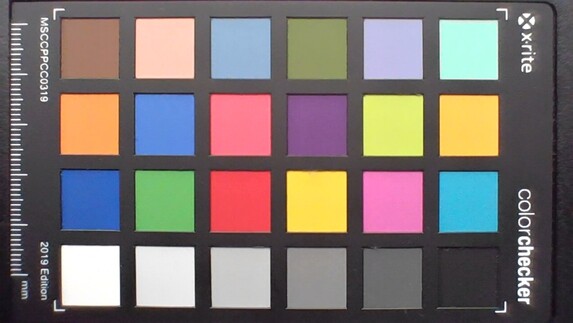
Manutenzione
Il pannello inferiore è fissato in posizione con alcune viti Torx (T5) e può essere facilmente rimosso. La RAM è saldata alla scheda madre, ma almeno l'SSD M.2 2280 e il modulo Wi-Fi sono sostituibili. Naturalmente, è possibile accedere e pulire la ventola dopo aver rimosso il pannello inferiore. La batteria è fissata solo da viti.
Dispositivi di input - Corsa breve dei tasti
La tastiera è uno degli aspetti più deboli dello Yoga Slim 7i. La sua corsa è breve, solo 1 mm. Si nota una differenza di qualità se la si confronta con le tastiere di altri modelli Lenovo come lo Yoga 7 14 e Yogi 9i. Inoltre, la digitazione dei tasti è relativamente rumorosa, il che non fa sentire la tastiera molto premium. La tastiera è sicuramente utilizzabile se non si digita molto, ma ci sono opzioni molto migliori in circolazione. Lenovo ha incluso una retroilluminazione bianca con due livelli di luminosità. La luce può anche essere attivata automaticamente con l'aiuto di un sensore.
Il liscio clickpad funziona molto bene e non ha problemi a riconoscere i gesti fino a quattro dita. Con dimensioni di 10,5 x 7 cm (4,1 x 2,8"), il clickpad è anche abbastanza spazioso. Tuttavia, come spesso accade con i touchpad, la pressione della sezione inferiore del clickpad richiede una forza relativamente elevata e crea un rumore molto forte, che fa sembrare il touchpad piuttosto economico. Nell'uso quotidiano, è molto più comodo toccare il touchpad per fare clic. Il touchscreen funziona molto bene nonostante la superficie antiriflesso.
Display - touchscreen WQHD a 90 Hz
Lo Yoga Slim 7i Carbon è disponibile con due diverse opzioni di pannello WQHD, una con e una senza funzionalità touch. La nostra unità in prova è dotata del touchscreen opzionale con superficie antiriflesso. Sebbene il display sia molto meno riflettente di quelli privi di questa caratteristica, riflette comunque più luce rispetto ai display opachi. Il display 16:10 ha una risoluzione di 2.560 x 1.600 e ci sembra eccellente. I contenuti sullo schermo sono nitidi e i colori appaiono vivaci. Inoltre, il pannello è in grado di raggiungere una frequenza di aggiornamento di 90 Hz, il che significa che il movimento apparirà molto fluido sullo schermo. Il display supporta anche l'HDR e la luminosità dello schermo può essere regolata automaticamente con l'aiuto di un sensore.
Lo Yoga Slim 7i Carbon utilizza un pannello diverso da quello del suo predecessore. Sebbene il nuovo pannello sia leggermente più luminoso, la sua luminosità di picco è inferiore a quella dichiarata dal produttore di 400 cd/m² e riesce a raggiungere solo 362 cd/m² in media, collocando lo Yoga Slim 7i Carbon in fondo al nostro confronto. Tuttavia, il display ha un buon livello di nero di 0,26 cd/m², che si traduce in un elevato rapporto di contrasto di circa 1.500:1. Il bleeding dello schermo è difficilmente visibile. Il bleeding dello schermo è difficilmente visibile. Il pannello IPS non utilizza PWM e ha un angolo di visione molto ampio.
| |||||||||||||||||||||||||
Distribuzione della luminosità: 87 %
Al centro con la batteria: 391 cd/m²
Contrasto: 1504:1 (Nero: 0.26 cd/m²)
ΔE ColorChecker Calman: 1 | ∀{0.5-29.43 Ø4.78}
ΔE Greyscale Calman: 1.7 | ∀{0.09-98 Ø5}
69.1% AdobeRGB 1998 (Argyll 3D)
98.9% sRGB (Argyll 3D)
67.3% Display P3 (Argyll 3D)
Gamma: 2.22
CCT: 6808 K
| Lenovo Yoga Slim 7 Carbon 13IAP7-82U9005FGE MND307DA1-9, IPS, 2560x1600, 13.3" | Asus Zenbook S 13 OLED SDC4172, OLED, 2880x1800, 13.3" | Dell XPS 13 Plus 9320 i5-1240p Sharp SHP1548 LQ134N1, IPS, 1920x1200, 13.4" | Apple MacBook Air M2 Entry IPS, 2560x1664, 13.6" | Samsung Galaxy Book2 Pro 13 NP930XED-KA1DE ATNA33XC10-0, OLED, 1920x1080, 13.3" | Lenovo ThinkBook 13s G3 20YA0005GE M133NW4JR0, IPS, 1920x1200, 13.3" | Lenovo Yoga Slim 7i Carbon 13 ITL N133GCA-GQ1, a-SI IPS LED, 2560x1600, 13.3" | |
|---|---|---|---|---|---|---|---|
| Display | 30% | 2% | 25% | 29% | -1% | -3% | |
| Display P3 Coverage (%) | 67.3 | 99.8 48% | 69 3% | 98.4 46% | 99.81 48% | 67.5 0% | 65.1 -3% |
| sRGB Coverage (%) | 98.9 | 100 1% | 99 0% | 99.9 1% | 100 1% | 97.1 -2% | 97.1 -2% |
| AdobeRGB 1998 Coverage (%) | 69.1 | 97.8 42% | 71 3% | 87.6 27% | 95.55 38% | 68.8 0% | 66.6 -4% |
| Response Times | 93% | -25% | -18% | 89% | -70% | -15% | |
| Response Time Grey 50% / Grey 80% * (ms) | 34 ? | 2.1 ? 94% | 45 ? -32% | 32.9 ? 3% | 4 ? 88% | 53.2 ? -56% | 38.4 ? -13% |
| Response Time Black / White * (ms) | 17.9 ? | 1.68 ? 91% | 21 ? -17% | 24.9 ? -39% | 2 ? 89% | 32.8 ? -83% | 20.8 ? -16% |
| PWM Frequency (Hz) | 240.4 ? | 61 ? | |||||
| Screen | 126% | -88% | -6% | 36% | -9% | -36% | |
| Brightness middle (cd/m²) | 391 | 336 -14% | 498 27% | 526 35% | 399 2% | 379 -3% | 325 -17% |
| Brightness (cd/m²) | 362 | 338 -7% | 460 27% | 486 34% | 403 11% | 356 -2% | 297 -18% |
| Brightness Distribution (%) | 87 | 99 14% | 85 -2% | 87 0% | 98 13% | 88 1% | 83 -5% |
| Black Level * (cd/m²) | 0.26 | 0.02 92% | 0.53 -104% | 0.38 -46% | 0.07 73% | 0.23 12% | 0.26 -0% |
| Contrast (:1) | 1504 | 16800 1017% | 940 -37% | 1384 -8% | 5700 279% | 1648 10% | 1250 -17% |
| Colorchecker dE 2000 * | 1 | 1.8 -80% | 3.65 -265% | 1.3 -30% | 1.35 -35% | 1.6 -60% | 2.2 -120% |
| Colorchecker dE 2000 max. * | 2.4 | 3.8 -58% | 7.11 -196% | 2.7 -13% | 2.77 -15% | 2.7 -13% | 3.5 -46% |
| Greyscale dE 2000 * | 1.7 | 0.9 47% | 4.25 -150% | 2 -18% | 2.35 -38% | 2 -18% | 2.8 -65% |
| Gamma | 2.22 99% | 2.22 99% | 2.45 90% | 2.25 98% | 2.21 100% | 2.25 98% | 2.05 107% |
| CCT | 6808 95% | 6580 99% | 6690 97% | 6858 95% | 6824 95% | 6835 95% | 6452 101% |
| Colorchecker dE 2000 calibrated * | 1.8 | 2.16 | 0.7 | 1.35 | 1 | 0.6 | |
| Color Space (Percent of AdobeRGB 1998) (%) | 61.3 | ||||||
| Color Space (Percent of sRGB) (%) | 97 | ||||||
| Media totale (Programma / Settaggio) | 83% /
99% | -37% /
-57% | 0% /
-1% | 51% /
43% | -27% /
-16% | -18% /
-25% |
* ... Meglio usare valori piccoli
Lenovo sostiene che il display è già calibrato in fabbrica, cosa che possiamo confermare dopo averlo analizzato con il software professionale CalMAN (X-Rite i1 Pro 2). Anche se ha una leggera sfumatura blu e la sua temperatura di colore è un po' fredda, non si nota nell'uso quotidiano. Subito dopo l'acquisto, la differenza cromatica media era ben al di sotto della soglia cruciale di 3 quando si utilizzava la gamma di colori sRGB come riferimento. In seguito abbiamo calibrato il pannello, ma non siamo riusciti a migliorare ulteriormente l'accuratezza del colore del display. Pertanto, non forniremo alcun profilo di colore da scaricare. Il display è in grado di coprire quasi l'intero spazio colore sRGB ed è quindi adatto all'editing di foto e video.
Tempi di risposta del Display
| ↔ Tempi di risposta dal Nero al Bianco | ||
|---|---|---|
| 17.9 ms ... aumenta ↗ e diminuisce ↘ combinato | ↗ 7.2 ms Incremento | |
| ↘ 10.7 ms Calo | ||
| Lo schermo mostra buoni tempi di risposta durante i nostri tests, ma potrebbe essere troppo lento per i gamers competitivi. In confronto, tutti i dispositivi di test variano da 0.1 (minimo) a 240 (massimo) ms. » 39 % di tutti i dispositivi è migliore. Questo significa che i tempi di risposta rilevati sono migliori rispettto alla media di tutti i dispositivi testati (20.2 ms). | ||
| ↔ Tempo di risposta dal 50% Grigio all'80% Grigio | ||
| 34 ms ... aumenta ↗ e diminuisce ↘ combinato | ↗ 15.9 ms Incremento | |
| ↘ 18.1 ms Calo | ||
| Lo schermo mostra tempi di risposta lenti nei nostri tests e sarà insoddisfacente per i gamers. In confronto, tutti i dispositivi di test variano da 0.165 (minimo) a 636 (massimo) ms. » 45 % di tutti i dispositivi è migliore. Questo significa che i tempi di risposta rilevati sono simili alla media di tutti i dispositivi testati (31.6 ms). | ||
Sfarfallio dello schermo / PWM (Pulse-Width Modulation)
| flickering dello schermo / PWM non rilevato | |||
In confronto: 53 % di tutti i dispositivi testati non utilizza PWM per ridurre la luminosita' del display. Se è rilevato PWM, una media di 8108 (minimo: 5 - massimo: 343500) Hz è stata rilevata. | |||
Lo schermo antiriflesso ha più limiti di un pannello opaco quando si tratta di utilizzare il dispositivo all'aperto. Inoltre, vorremmo che il display fosse più luminoso. In una giornata molto luminosa, probabilmente è necessario trovare un posto all'ombra se si vuole essere in grado di lavorare correttamente all'esterno.
Prestazioni - Alimentato da Alder Lake-P
Condizioni di prova
Come la maggior parte dei laptop consumer Lenovo, lo Yoga Slim 7i è dotato del software Lenovo Vantage, che offre tre modalità di prestazioni (Battery Saver, Intelligent Cooling e High Performance) oltre ai piani energetici di Windows. È possibile passare da una all'altra premendo Fn+P. Nella nostra unità di prova, siamo rimasti sorpresi dal fatto che le prestazioni sono rimaste invariate in tutte e tre le modalità. Durante i nostri test, il processore si è sempre stabilizzato a 28 watt dopo aver funzionato inizialmente a 46 watt per circa 20 secondi, indipendentemente dalla modalità selezionata. L'unica differenza che abbiamo notato è stata la quantità di rumore generato dalla ventola. Per i nostri test abbiamo utilizzato l'impostazione "Intelligent Cooling". Inoltre, non consigliamo di utilizzare la modalità "Battery Saver" quando il portatile è sotto carico, in quanto le temperature superficiali potrebbero diventare troppo elevate (per maggiori informazioni, vedere più avanti). È probabile che Lenovo continui ad apportare modifiche in questo ambito tramite gli aggiornamenti BIO.
Processore - Core i7-1260P
Ci si potrebbe aspettare di trovare un processore della serie U in un dispositivo così leggero e compatto. Invece Lenovo ha scelto di utilizzare una CPU Alder Lake-P più potente, con due core aggiuntivi per le prestazioni. Mentre il modello base è dotato di un Core i5-1240Pla nostra unità in prova è dotata di un più veloce Core i7-1260P. Le prestazioni della CPU sono sorprendentemente buone. Poiché il processore ha funzionato per breve tempo a 46 watt prima di stabilizzarsi a 28 watt, lo Yoga Slim 7i Carbon si è comportato bene nei brevi benchmark ed è stato eccellente nel gestire brevi picchi di carico.
Cinebench R15 Multi Sustained Load
Questo comportamento è visibile anche nel test Cinebench multi-loop: le prestazioni del portatile sono calate significativamente dopo la prima esecuzione. Tuttavia, lo Yoga Slim è ancora molto competitivo e offre più del doppio delle prestazioni del suo predecessore (con un Tiger Lake Core i7-1165G7) in scenari multi-core. A parte questo, il AMD Ryzen 7 6800U nel modello Asus Zenbook S 13 è ancora un po' più veloce e consuma anche un po' meno
Le prestazioni single-core del Core i7 sono eccellenti e superiori a quelle degli attuali chip AMD. Questo, tuttavia, ha il prezzo di un maggiore consumo energetico. La CPU offre prestazioni costanti quando funziona a batteria. È possibile visitare questa pagina per trovare altri benchmark della CPU.
Cinebench R23: Multi Core | Single Core
Cinebench R20: CPU (Multi Core) | CPU (Single Core)
Cinebench R15: CPU Multi 64Bit | CPU Single 64Bit
Blender: v2.79 BMW27 CPU
7-Zip 18.03: 7z b 4 | 7z b 4 -mmt1
Geekbench 5.5: Multi-Core | Single-Core
HWBOT x265 Benchmark v2.2: 4k Preset
LibreOffice : 20 Documents To PDF
R Benchmark 2.5: Overall mean
| CPU Performance rating | |
| Media della classe Subnotebook | |
| Lenovo Yoga Slim 7 Carbon 13IAP7-82U9005FGE | |
| Asus Zenbook S 13 OLED | |
| Media Intel Core i7-1260P | |
| Dell XPS 13 Plus 9320 i5-1240p | |
| Lenovo ThinkBook 13s G3 20YA0005GE | |
| Apple MacBook Air M2 Entry -5! | |
| Lenovo Yoga Slim 7i Carbon 13 ITL | |
| Samsung Galaxy Book2 Pro 13 NP930XED-KA1DE | |
| Cinebench R23 / Multi Core | |
| Media della classe Subnotebook (1555 - 21812, n=74, ultimi 2 anni) | |
| Asus Zenbook S 13 OLED | |
| Lenovo Yoga Slim 7 Carbon 13IAP7-82U9005FGE | |
| Dell XPS 13 Plus 9320 i5-1240p | |
| Media Intel Core i7-1260P (3173 - 12150, n=27) | |
| Apple MacBook Air M2 Entry | |
| Lenovo ThinkBook 13s G3 20YA0005GE | |
| Samsung Galaxy Book2 Pro 13 NP930XED-KA1DE | |
| Lenovo Yoga Slim 7i Carbon 13 ITL | |
| Cinebench R23 / Single Core | |
| Lenovo Yoga Slim 7 Carbon 13IAP7-82U9005FGE | |
| Media della classe Subnotebook (358 - 2165, n=75, ultimi 2 anni) | |
| Media Intel Core i7-1260P (1155 - 1812, n=25) | |
| Dell XPS 13 Plus 9320 i5-1240p | |
| Apple MacBook Air M2 Entry | |
| Asus Zenbook S 13 OLED | |
| Lenovo ThinkBook 13s G3 20YA0005GE | |
| Lenovo Yoga Slim 7i Carbon 13 ITL | |
| Samsung Galaxy Book2 Pro 13 NP930XED-KA1DE | |
| Cinebench R20 / CPU (Multi Core) | |
| Media della classe Subnotebook (579 - 8541, n=69, ultimi 2 anni) | |
| Asus Zenbook S 13 OLED | |
| Lenovo Yoga Slim 7 Carbon 13IAP7-82U9005FGE | |
| Media Intel Core i7-1260P (1234 - 4748, n=25) | |
| Dell XPS 13 Plus 9320 i5-1240p | |
| Lenovo ThinkBook 13s G3 20YA0005GE | |
| Apple MacBook Air M2 Entry | |
| Samsung Galaxy Book2 Pro 13 NP930XED-KA1DE | |
| Lenovo Yoga Slim 7i Carbon 13 ITL | |
| Cinebench R20 / CPU (Single Core) | |
| Lenovo Yoga Slim 7 Carbon 13IAP7-82U9005FGE | |
| Media della classe Subnotebook (128 - 826, n=69, ultimi 2 anni) | |
| Media Intel Core i7-1260P (448 - 698, n=25) | |
| Dell XPS 13 Plus 9320 i5-1240p | |
| Asus Zenbook S 13 OLED | |
| Lenovo ThinkBook 13s G3 20YA0005GE | |
| Lenovo Yoga Slim 7i Carbon 13 ITL | |
| Samsung Galaxy Book2 Pro 13 NP930XED-KA1DE | |
| Apple MacBook Air M2 Entry | |
| Cinebench R15 / CPU Multi 64Bit | |
| Media della classe Subnotebook (327 - 3345, n=69, ultimi 2 anni) | |
| Lenovo ThinkBook 13s G3 20YA0005GE | |
| Lenovo ThinkBook 13s G3 20YA0005GE | |
| Lenovo Yoga Slim 7 Carbon 13IAP7-82U9005FGE | |
| Asus Zenbook S 13 OLED | |
| Dell XPS 13 Plus 9320 i5-1240p | |
| Media Intel Core i7-1260P (549 - 2034, n=29) | |
| Apple MacBook Air M2 Entry | |
| Samsung Galaxy Book2 Pro 13 NP930XED-KA1DE | |
| Lenovo Yoga Slim 7i Carbon 13 ITL | |
| Cinebench R15 / CPU Single 64Bit | |
| Media della classe Subnotebook (72.4 - 322, n=69, ultimi 2 anni) | |
| Lenovo Yoga Slim 7 Carbon 13IAP7-82U9005FGE | |
| Asus Zenbook S 13 OLED | |
| Media Intel Core i7-1260P (165.4 - 260, n=27) | |
| Lenovo ThinkBook 13s G3 20YA0005GE | |
| Dell XPS 13 Plus 9320 i5-1240p | |
| Apple MacBook Air M2 Entry | |
| Lenovo Yoga Slim 7i Carbon 13 ITL | |
| Samsung Galaxy Book2 Pro 13 NP930XED-KA1DE | |
| Blender / v2.79 BMW27 CPU | |
| Lenovo Yoga Slim 7i Carbon 13 ITL | |
| Apple MacBook Air M2 Entry | |
| Samsung Galaxy Book2 Pro 13 NP930XED-KA1DE | |
| Lenovo ThinkBook 13s G3 20YA0005GE | |
| Dell XPS 13 Plus 9320 i5-1240p | |
| Media Intel Core i7-1260P (264 - 906, n=26) | |
| Media della classe Subnotebook (159 - 2271, n=72, ultimi 2 anni) | |
| Lenovo Yoga Slim 7 Carbon 13IAP7-82U9005FGE | |
| Asus Zenbook S 13 OLED | |
| 7-Zip 18.03 / 7z b 4 | |
| Asus Zenbook S 13 OLED | |
| Media della classe Subnotebook (11668 - 77867, n=69, ultimi 2 anni) | |
| Dell XPS 13 Plus 9320 i5-1240p | |
| Lenovo Yoga Slim 7 Carbon 13IAP7-82U9005FGE | |
| Lenovo ThinkBook 13s G3 20YA0005GE | |
| Media Intel Core i7-1260P (16146 - 47064, n=25) | |
| Samsung Galaxy Book2 Pro 13 NP930XED-KA1DE | |
| Lenovo Yoga Slim 7i Carbon 13 ITL | |
| 7-Zip 18.03 / 7z b 4 -mmt1 | |
| Media della classe Subnotebook (2643 - 6442, n=71, ultimi 2 anni) | |
| Asus Zenbook S 13 OLED | |
| Lenovo Yoga Slim 7 Carbon 13IAP7-82U9005FGE | |
| Lenovo ThinkBook 13s G3 20YA0005GE | |
| Media Intel Core i7-1260P (4064 - 5791, n=25) | |
| Lenovo Yoga Slim 7i Carbon 13 ITL | |
| Dell XPS 13 Plus 9320 i5-1240p | |
| Samsung Galaxy Book2 Pro 13 NP930XED-KA1DE | |
| Geekbench 5.5 / Multi-Core | |
| Media della classe Subnotebook (2557 - 17218, n=64, ultimi 2 anni) | |
| Lenovo Yoga Slim 7 Carbon 13IAP7-82U9005FGE | |
| Apple MacBook Air M2 Entry | |
| Media Intel Core i7-1260P (3866 - 10570, n=25) | |
| Asus Zenbook S 13 OLED | |
| Lenovo ThinkBook 13s G3 20YA0005GE | |
| Lenovo Yoga Slim 7i Carbon 13 ITL | |
| Samsung Galaxy Book2 Pro 13 NP930XED-KA1DE | |
| Dell XPS 13 Plus 9320 i5-1240p | |
| Geekbench 5.5 / Single-Core | |
| Apple MacBook Air M2 Entry | |
| Media della classe Subnotebook (726 - 2350, n=64, ultimi 2 anni) | |
| Lenovo Yoga Slim 7 Carbon 13IAP7-82U9005FGE | |
| Media Intel Core i7-1260P (1436 - 1786, n=25) | |
| Dell XPS 13 Plus 9320 i5-1240p | |
| Lenovo Yoga Slim 7i Carbon 13 ITL | |
| Asus Zenbook S 13 OLED | |
| Lenovo ThinkBook 13s G3 20YA0005GE | |
| Samsung Galaxy Book2 Pro 13 NP930XED-KA1DE | |
| HWBOT x265 Benchmark v2.2 / 4k Preset | |
| Media della classe Subnotebook (0.97 - 25.1, n=69, ultimi 2 anni) | |
| Asus Zenbook S 13 OLED | |
| Dell XPS 13 Plus 9320 i5-1240p | |
| Lenovo Yoga Slim 7 Carbon 13IAP7-82U9005FGE | |
| Media Intel Core i7-1260P (3.45 - 13.6, n=26) | |
| Lenovo ThinkBook 13s G3 20YA0005GE | |
| Samsung Galaxy Book2 Pro 13 NP930XED-KA1DE | |
| Lenovo Yoga Slim 7i Carbon 13 ITL | |
| LibreOffice / 20 Documents To PDF | |
| Samsung Galaxy Book2 Pro 13 NP930XED-KA1DE | |
| Dell XPS 13 Plus 9320 i5-1240p | |
| Media della classe Subnotebook (38.5 - 220, n=68, ultimi 2 anni) | |
| Asus Zenbook S 13 OLED | |
| Lenovo ThinkBook 13s G3 20YA0005GE | |
| Lenovo Yoga Slim 7i Carbon 13 ITL | |
| Media Intel Core i7-1260P (40.2 - 65.7, n=25) | |
| Lenovo Yoga Slim 7 Carbon 13IAP7-82U9005FGE | |
| R Benchmark 2.5 / Overall mean | |
| Samsung Galaxy Book2 Pro 13 NP930XED-KA1DE | |
| Lenovo Yoga Slim 7i Carbon 13 ITL | |
| Lenovo ThinkBook 13s G3 20YA0005GE | |
| Asus Zenbook S 13 OLED | |
| Media della classe Subnotebook (0.403 - 1.456, n=70, ultimi 2 anni) | |
| Dell XPS 13 Plus 9320 i5-1240p | |
| Media Intel Core i7-1260P (0.4559 - 0.727, n=25) | |
| Lenovo Yoga Slim 7 Carbon 13IAP7-82U9005FGE | |
* ... Meglio usare valori piccoli
AIDA64: FP32 Ray-Trace | FPU Julia | CPU SHA3 | CPU Queen | FPU SinJulia | FPU Mandel | CPU AES | CPU ZLib | FP64 Ray-Trace | CPU PhotoWorxx
| Performance rating | |
| Media della classe Subnotebook | |
| Asus Zenbook S 13 OLED | |
| Lenovo ThinkBook 13s G3 20YA0005GE | |
| Media Intel Core i7-1260P | |
| Dell XPS 13 Plus 9320 i5-1240p | |
| Lenovo Yoga Slim 7 Carbon 13IAP7-82U9005FGE | |
| Samsung Galaxy Book2 Pro 13 NP930XED-KA1DE | |
| AIDA64 / FP32 Ray-Trace | |
| Media della classe Subnotebook (1135 - 32888, n=68, ultimi 2 anni) | |
| Lenovo ThinkBook 13s G3 20YA0005GE | |
| Asus Zenbook S 13 OLED | |
| Media Intel Core i7-1260P (2176 - 10898, n=26) | |
| Dell XPS 13 Plus 9320 i5-1240p | |
| Lenovo Yoga Slim 7 Carbon 13IAP7-82U9005FGE | |
| Samsung Galaxy Book2 Pro 13 NP930XED-KA1DE | |
| AIDA64 / FPU Julia | |
| Lenovo ThinkBook 13s G3 20YA0005GE | |
| Asus Zenbook S 13 OLED | |
| Media della classe Subnotebook (5218 - 123315, n=68, ultimi 2 anni) | |
| Media Intel Core i7-1260P (11015 - 56906, n=26) | |
| Lenovo Yoga Slim 7 Carbon 13IAP7-82U9005FGE | |
| Dell XPS 13 Plus 9320 i5-1240p | |
| Samsung Galaxy Book2 Pro 13 NP930XED-KA1DE | |
| AIDA64 / CPU SHA3 | |
| Media della classe Subnotebook (444 - 5287, n=68, ultimi 2 anni) | |
| Lenovo ThinkBook 13s G3 20YA0005GE | |
| Asus Zenbook S 13 OLED | |
| Media Intel Core i7-1260P (669 - 2709, n=26) | |
| Dell XPS 13 Plus 9320 i5-1240p | |
| Lenovo Yoga Slim 7 Carbon 13IAP7-82U9005FGE | |
| Samsung Galaxy Book2 Pro 13 NP930XED-KA1DE | |
| AIDA64 / CPU Queen | |
| Lenovo ThinkBook 13s G3 20YA0005GE | |
| Asus Zenbook S 13 OLED | |
| Lenovo Yoga Slim 7 Carbon 13IAP7-82U9005FGE | |
| Dell XPS 13 Plus 9320 i5-1240p | |
| Media Intel Core i7-1260P (42571 - 82493, n=26) | |
| Media della classe Subnotebook (10579 - 115682, n=68, ultimi 2 anni) | |
| Samsung Galaxy Book2 Pro 13 NP930XED-KA1DE | |
| AIDA64 / FPU SinJulia | |
| Lenovo ThinkBook 13s G3 20YA0005GE | |
| Asus Zenbook S 13 OLED | |
| Media della classe Subnotebook (744 - 18418, n=68, ultimi 2 anni) | |
| Lenovo Yoga Slim 7 Carbon 13IAP7-82U9005FGE | |
| Dell XPS 13 Plus 9320 i5-1240p | |
| Media Intel Core i7-1260P (2901 - 6975, n=26) | |
| Samsung Galaxy Book2 Pro 13 NP930XED-KA1DE | |
| AIDA64 / FPU Mandel | |
| Lenovo ThinkBook 13s G3 20YA0005GE | |
| Asus Zenbook S 13 OLED | |
| Media della classe Subnotebook (3341 - 65433, n=68, ultimi 2 anni) | |
| Media Intel Core i7-1260P (5950 - 26376, n=26) | |
| Dell XPS 13 Plus 9320 i5-1240p | |
| Lenovo Yoga Slim 7 Carbon 13IAP7-82U9005FGE | |
| Samsung Galaxy Book2 Pro 13 NP930XED-KA1DE | |
| AIDA64 / CPU AES | |
| Asus Zenbook S 13 OLED | |
| Lenovo ThinkBook 13s G3 20YA0005GE | |
| Media della classe Subnotebook (638 - 161430, n=68, ultimi 2 anni) | |
| Media Intel Core i7-1260P (16041 - 92356, n=26) | |
| Dell XPS 13 Plus 9320 i5-1240p | |
| Lenovo Yoga Slim 7 Carbon 13IAP7-82U9005FGE | |
| Samsung Galaxy Book2 Pro 13 NP930XED-KA1DE | |
| AIDA64 / CPU ZLib | |
| Media della classe Subnotebook (164.9 - 1379, n=68, ultimi 2 anni) | |
| Lenovo ThinkBook 13s G3 20YA0005GE | |
| Dell XPS 13 Plus 9320 i5-1240p | |
| Asus Zenbook S 13 OLED | |
| Lenovo Yoga Slim 7 Carbon 13IAP7-82U9005FGE | |
| Media Intel Core i7-1260P (259 - 771, n=26) | |
| Samsung Galaxy Book2 Pro 13 NP930XED-KA1DE | |
| AIDA64 / FP64 Ray-Trace | |
| Media della classe Subnotebook (610 - 17495, n=68, ultimi 2 anni) | |
| Lenovo ThinkBook 13s G3 20YA0005GE | |
| Asus Zenbook S 13 OLED | |
| Media Intel Core i7-1260P (1237 - 5858, n=26) | |
| Dell XPS 13 Plus 9320 i5-1240p | |
| Lenovo Yoga Slim 7 Carbon 13IAP7-82U9005FGE | |
| Samsung Galaxy Book2 Pro 13 NP930XED-KA1DE | |
| AIDA64 / CPU PhotoWorxx | |
| Media della classe Subnotebook (6569 - 64588, n=68, ultimi 2 anni) | |
| Dell XPS 13 Plus 9320 i5-1240p | |
| Lenovo Yoga Slim 7 Carbon 13IAP7-82U9005FGE | |
| Media Intel Core i7-1260P (13261 - 43652, n=26) | |
| Samsung Galaxy Book2 Pro 13 NP930XED-KA1DE | |
| Asus Zenbook S 13 OLED | |
| Lenovo ThinkBook 13s G3 20YA0005GE | |
Prestazioni del sistema
Come previsto, non ci sono stati problemi per quanto riguarda le prestazioni del sistema. Oltre all'eccellente esperienza d'uso, il portatile ha ottenuto ottimi risultati anche nei benchmark. Non abbiamo notato alcun problema durante i nostri test.
CrossMark: Overall | Productivity | Creativity | Responsiveness
| PCMark 10 / Score | |
| Media della classe Subnotebook (4920 - 8424, n=55, ultimi 2 anni) | |
| Asus Zenbook S 13 OLED | |
| Lenovo ThinkBook 13s G3 20YA0005GE | |
| Lenovo Yoga Slim 7 Carbon 13IAP7-82U9005FGE | |
| Media Intel Core i7-1260P, Intel Iris Xe Graphics G7 96EUs (4796 - 6068, n=17) | |
| Lenovo Yoga Slim 7i Carbon 13 ITL | |
| Dell XPS 13 Plus 9320 i5-1240p | |
| Samsung Galaxy Book2 Pro 13 NP930XED-KA1DE | |
| PCMark 10 / Essentials | |
| Asus Zenbook S 13 OLED | |
| Lenovo Yoga Slim 7 Carbon 13IAP7-82U9005FGE | |
| Media della classe Subnotebook (8552 - 11406, n=55, ultimi 2 anni) | |
| Media Intel Core i7-1260P, Intel Iris Xe Graphics G7 96EUs (9260 - 11251, n=17) | |
| Lenovo ThinkBook 13s G3 20YA0005GE | |
| Lenovo Yoga Slim 7i Carbon 13 ITL | |
| Samsung Galaxy Book2 Pro 13 NP930XED-KA1DE | |
| Dell XPS 13 Plus 9320 i5-1240p | |
| PCMark 10 / Productivity | |
| Lenovo ThinkBook 13s G3 20YA0005GE | |
| Media della classe Subnotebook (5435 - 16132, n=55, ultimi 2 anni) | |
| Asus Zenbook S 13 OLED | |
| Media Intel Core i7-1260P, Intel Iris Xe Graphics G7 96EUs (6167 - 8629, n=17) | |
| Lenovo Yoga Slim 7i Carbon 13 ITL | |
| Lenovo Yoga Slim 7 Carbon 13IAP7-82U9005FGE | |
| Dell XPS 13 Plus 9320 i5-1240p | |
| Samsung Galaxy Book2 Pro 13 NP930XED-KA1DE | |
| PCMark 10 / Digital Content Creation | |
| Media della classe Subnotebook (5722 - 12442, n=55, ultimi 2 anni) | |
| Asus Zenbook S 13 OLED | |
| Lenovo Yoga Slim 7 Carbon 13IAP7-82U9005FGE | |
| Media Intel Core i7-1260P, Intel Iris Xe Graphics G7 96EUs (5231 - 6908, n=17) | |
| Lenovo ThinkBook 13s G3 20YA0005GE | |
| Dell XPS 13 Plus 9320 i5-1240p | |
| Samsung Galaxy Book2 Pro 13 NP930XED-KA1DE | |
| Lenovo Yoga Slim 7i Carbon 13 ITL | |
| CrossMark / Overall | |
| Media Intel Core i7-1260P, Intel Iris Xe Graphics G7 96EUs (1484 - 1811, n=16) | |
| Lenovo Yoga Slim 7 Carbon 13IAP7-82U9005FGE | |
| Media della classe Subnotebook (365 - 2038, n=69, ultimi 2 anni) | |
| Apple MacBook Air M2 Entry | |
| Asus Zenbook S 13 OLED | |
| Dell XPS 13 Plus 9320 i5-1240p | |
| Lenovo ThinkBook 13s G3 20YA0005GE | |
| CrossMark / Productivity | |
| Media Intel Core i7-1260P, Intel Iris Xe Graphics G7 96EUs (1486 - 1755, n=16) | |
| Lenovo Yoga Slim 7 Carbon 13IAP7-82U9005FGE | |
| Media della classe Subnotebook (364 - 1918, n=69, ultimi 2 anni) | |
| Asus Zenbook S 13 OLED | |
| Dell XPS 13 Plus 9320 i5-1240p | |
| Apple MacBook Air M2 Entry | |
| Lenovo ThinkBook 13s G3 20YA0005GE | |
| CrossMark / Creativity | |
| Apple MacBook Air M2 Entry | |
| Media della classe Subnotebook (372 - 2396, n=69, ultimi 2 anni) | |
| Lenovo Yoga Slim 7 Carbon 13IAP7-82U9005FGE | |
| Media Intel Core i7-1260P, Intel Iris Xe Graphics G7 96EUs (1451 - 1872, n=16) | |
| Dell XPS 13 Plus 9320 i5-1240p | |
| Asus Zenbook S 13 OLED | |
| Lenovo ThinkBook 13s G3 20YA0005GE | |
| CrossMark / Responsiveness | |
| Media Intel Core i7-1260P, Intel Iris Xe Graphics G7 96EUs (1253 - 1807, n=16) | |
| Lenovo Yoga Slim 7 Carbon 13IAP7-82U9005FGE | |
| Media della classe Subnotebook (312 - 1889, n=69, ultimi 2 anni) | |
| Dell XPS 13 Plus 9320 i5-1240p | |
| Asus Zenbook S 13 OLED | |
| Lenovo ThinkBook 13s G3 20YA0005GE | |
| Apple MacBook Air M2 Entry | |
| PCMark 10 Score | 5598 punti | |
Aiuto | ||
| AIDA64 / Memory Copy | |
| Media della classe Subnotebook (14554 - 109035, n=68, ultimi 2 anni) | |
| Dell XPS 13 Plus 9320 i5-1240p | |
| Lenovo Yoga Slim 7 Carbon 13IAP7-82U9005FGE | |
| Samsung Galaxy Book2 Pro 13 NP930XED-KA1DE | |
| Media Intel Core i7-1260P (25125 - 71544, n=25) | |
| Asus Zenbook S 13 OLED | |
| Lenovo ThinkBook 13s G3 20YA0005GE | |
| AIDA64 / Memory Read | |
| Media della classe Subnotebook (15948 - 127174, n=68, ultimi 2 anni) | |
| Dell XPS 13 Plus 9320 i5-1240p | |
| Lenovo Yoga Slim 7 Carbon 13IAP7-82U9005FGE | |
| Media Intel Core i7-1260P (24983 - 72065, n=25) | |
| Samsung Galaxy Book2 Pro 13 NP930XED-KA1DE | |
| Asus Zenbook S 13 OLED | |
| Lenovo ThinkBook 13s G3 20YA0005GE | |
| AIDA64 / Memory Write | |
| Media della classe Subnotebook (15709 - 117898, n=68, ultimi 2 anni) | |
| Dell XPS 13 Plus 9320 i5-1240p | |
| Lenovo Yoga Slim 7 Carbon 13IAP7-82U9005FGE | |
| Samsung Galaxy Book2 Pro 13 NP930XED-KA1DE | |
| Media Intel Core i7-1260P (23512 - 66799, n=25) | |
| Asus Zenbook S 13 OLED | |
| Lenovo ThinkBook 13s G3 20YA0005GE | |
| AIDA64 / Memory Latency | |
| Asus Zenbook S 13 OLED | |
| Lenovo Yoga Slim 7 Carbon 13IAP7-82U9005FGE | |
| Lenovo ThinkBook 13s G3 20YA0005GE | |
| Media della classe Subnotebook (6.8 - 187.8, n=67, ultimi 2 anni) | |
| Media Intel Core i7-1260P (77.9 - 118.4, n=21) | |
* ... Meglio usare valori piccoli
Latenza DPC
Durante il nostro test di latenza standardizzato (navigazione web, riproduzione di video YouTube 4K, carico della CPU), l'unità in esame non ha mostrato alcun problema di rilievo quando ha utilizzato l'ultima versione del BIOS. Tuttavia, un driver (ACPI) ha causato alcuni problemi minori.
| DPC Latencies / LatencyMon - interrupt to process latency (max), Web, Youtube, Prime95 | |
| Samsung Galaxy Book2 Pro 13 NP930XED-KA1DE | |
| Dell XPS 13 Plus 9320 i5-1240p | |
| Lenovo Yoga Slim 7i Carbon 13 ITL | |
| Lenovo Yoga Slim 7 Carbon 13IAP7-82U9005FGE | |
| Asus Zenbook S 13 OLED | |
| Lenovo ThinkBook 13s G3 20YA0005GE | |
* ... Meglio usare valori piccoli
Memoria di massa
Lo Yoga Slim 7i Carbon 13 è dotato di un'unità SSD PCIe 4.0 Samsung (PM9A1), una delle unità più veloci attualmente sul mercato. Tuttavia, abbiamo notato che lo Yoga Slim soffre di un problema che riguarda anche molti altri portatili sottili e leggeri. Sebbene l'unità SSD sia in grado di fornire velocità di trasferimento molto elevate, superiori a 6 GB/s, le sue prestazioni iniziano a fluttuare drasticamente sotto carichi sostenuti a causa di problemi di calore. Nell'uso quotidiano, tuttavia, non si noterà alcuna limitazione perché le velocità di trasferimento dei dati sono ancora superiori a 3 GB/s. La nostra unità di prova ha una capacità di archiviazione di 1 TB, di cui 902 GB sono utilizzabili dopo la configurazione iniziale. Potete trovare altri benchmark sulle unità SSD qui.
| Drive Performance rating - Percent | |
| Media Samsung PM9A1 MZVL21T0HCLR | |
| Asus Zenbook S 13 OLED | |
| Lenovo Yoga Slim 7 Carbon 13IAP7-82U9005FGE | |
| Media della classe Subnotebook | |
| Lenovo Yoga Slim 7i Carbon 13 ITL | |
| Dell XPS 13 Plus 9320 i5-1240p | |
| Lenovo ThinkBook 13s G3 20YA0005GE | |
| Samsung Galaxy Book2 Pro 13 NP930XED-KA1DE | |
* ... Meglio usare valori piccoli
Sustained Read Performance: DiskSpd Read Loop, Queue Depth 8
Scheda grafica
Conosciamo già molto bene la grafica integrata Grafica Iris Xe G7 (96 EU) poiché è presente nelle CPU Intel Tiger Lake di ultima generazione. La GPU ha prestazioni sufficienti per gestire le attività multimediali quotidiane, compresa la riproduzione di video ad alta risoluzione. Tuttavia, l'iGPU AMD di attuale generazione, la Radeon 680Mè sostanzialmente più veloce e più efficiente. Questo vale anche per la iGPU del MacBook Air M2 di Apple
Inoltre, l'Iris Xe Graphics G7 non è adatta ai giochi. Nella maggior parte dei casi, ci si limiterà a eseguire i giochi a impostazioni medio-basse. Detto questo, la GPU è almeno in grado di fornire prestazioni stabili sotto carico sostenuto. Inoltre, è sempre possibile collegare una GPU esterna tramite la porta Thunderbolt 4 per migliorare le prestazioni di gioco. Questo dovrebbe funzionare abbastanza bene grazie alle buone prestazioni della CPU
Anche le prestazioni della GPU rimangono stabili quando si utilizza la batteria. Fare riferimento a il nostro elenco di schede grafiche per ulteriori benchmark della GPU.
| 3DMark Performance rating - Percent | |
| Media della classe Subnotebook | |
| Apple MacBook Air M2 Entry -4! | |
| Asus Zenbook S 13 OLED -1! | |
| Lenovo Yoga Slim 7 Carbon 13IAP7-82U9005FGE | |
| Lenovo Yoga Slim 7i Carbon 13 ITL -3! | |
| Media Intel Iris Xe Graphics G7 96EUs | |
| Lenovo ThinkBook 13s G3 20YA0005GE -2! | |
| Samsung Galaxy Book2 Pro 13 NP930XED-KA1DE -2! | |
| Dell XPS 13 Plus 9320 i5-1240p -2! | |
| 3DMark 11 - 1280x720 Performance GPU | |
| Media della classe Subnotebook (995 - 16296, n=65, ultimi 2 anni) | |
| Asus Zenbook S 13 OLED | |
| Lenovo Yoga Slim 7i Carbon 13 ITL | |
| Lenovo Yoga Slim 7 Carbon 13IAP7-82U9005FGE | |
| Media Intel Iris Xe Graphics G7 96EUs (2867 - 7676, n=209) | |
| Lenovo ThinkBook 13s G3 20YA0005GE | |
| Dell XPS 13 Plus 9320 i5-1240p | |
| Samsung Galaxy Book2 Pro 13 NP930XED-KA1DE | |
| 3DMark 11 Performance | 7039 punti | |
| 3DMark Cloud Gate Standard Score | 22062 punti | |
| 3DMark Fire Strike Score | 4895 punti | |
| 3DMark Time Spy Score | 1897 punti | |
Aiuto | ||
Witcher 3 FPS graph
| basso | medio | alto | ultra | QHD | |
|---|---|---|---|---|---|
| GTA V (2015) | 103.2 | 90.6 | 22.6 | 9.34 | |
| The Witcher 3 (2015) | 87 | 59 | 31 | 13.5 | |
| Dota 2 Reborn (2015) | 112.6 | 83 | 61.8 | 56 | |
| Final Fantasy XV Benchmark (2018) | 43 | 24.1 | 24.1 | 12.9 | |
| X-Plane 11.11 (2018) | 53.7 | 40.9 | 35.9 | ||
| Far Cry 5 (2018) | 51 | 28 | 26 | 24 | |
| Strange Brigade (2018) | 76.2 | 34.7 | 27.2 | 22.3 | |
| F1 2021 (2021) | 87 | 41.2 | 32.6 | 21.8 | |
| Farming Simulator 22 (2021) | 99 | 42 | 29 | 26 | |
| F1 22 (2022) | 36.3 | 33.5 | 24 | 16.5 |
Emissioni - Lo Yoga Slim 7i è caldo
Emissioni acustiche
All'interno dello Yoga Slim 7i Carbon 13 è presente una sola ventola di raffreddamento. Spesso non gira o gira quasi silenziosamente quando il portatile è inattivo o sta eseguendo attività molto semplici. Tuttavia, non appena si desidera che il portatile svolga attività più complesse, i limiti di potenza elevati diventano evidenti, poiché la ventola raggiunge rapidamente il suo livello di rumore massimo. Durante i nostri test, i livelli di rumore hanno raggiunto i 41,9 dB(A) in modalità "Intelligent Cooling" e i 43,6 dB(A) in modalità "High Performance". In modalità "Battery Saver", invece, il portatile si è dimostrato molto più silenzioso, producendo non più di 32,6 dB(A) di rumore. Nel complesso, il rumore della ventola si sente chiaramente, ma fortunatamente non è né acuto né fastidioso. Nell'unità in prova non abbiamo notato altri rumori provenienti dall'elettronica.
Rumorosità
| Idle |
| 24.2 / 24.2 / 25.1 dB(A) |
| Sotto carico |
| 41.9 / 41.9 dB(A) |
 | ||
30 dB silenzioso 40 dB(A) udibile 50 dB(A) rumoroso |
||
min: | ||
| Lenovo Yoga Slim 7 Carbon 13IAP7-82U9005FGE Iris Xe G7 96EUs, i7-1260P, Samsung PM9A1 MZVL21T0HCLR | Asus Zenbook S 13 OLED Radeon 680M, R7 6800U, Samsung PM9A1 MZVL21T0HCLR | Dell XPS 13 Plus 9320 i5-1240p Iris Xe G7 80EUs, i5-1240P, Micron 3400 MTFDKBA512TFH 512GB | Samsung Galaxy Book2 Pro 13 NP930XED-KA1DE Iris Xe G7 80EUs, i5-1240P, Samsung PM991a MZVLQ256HBJD | Lenovo ThinkBook 13s G3 20YA0005GE Vega 8, R7 5800U, WDC PC SN530 SDBPNPZ-512G | Lenovo Yoga Slim 7i Carbon 13 ITL Iris Xe G7 96EUs, i7-1165G7, Samsung SSD PM981a MZVLB512HBJQ | |
|---|---|---|---|---|---|---|
| Noise | 5% | -5% | 1% | -5% | -7% | |
| off /ambiente * (dB) | 24.2 | 24 1% | 26 -7% | 24.6 -2% | 24.7 -2% | 28.7 -19% |
| Idle Minimum * (dB) | 24.2 | 24 1% | 26.2 -8% | 24.6 -2% | 24.7 -2% | 28.7 -19% |
| Idle Average * (dB) | 24.2 | 24 1% | 26.2 -8% | 24.6 -2% | 27 -12% | 28.7 -19% |
| Idle Maximum * (dB) | 25.1 | 24 4% | 26.2 -4% | 26.3 -5% | 29.8 -19% | 30.6 -22% |
| Load Average * (dB) | 41.9 | 33.1 21% | 38.4 8% | 38.4 8% | 42.4 -1% | 37.3 11% |
| Witcher 3 ultra * (dB) | 41.9 | 40.2 4% | 42.4 -1% | 37.3 11% | ||
| Load Maximum * (dB) | 41.9 | 41.7 -0% | 47.1 -12% | 38.7 8% | 42.4 -1% | 37.3 11% |
* ... Meglio usare valori piccoli
Temperatura
Il portatile non presenta problemi di calore quando si eseguono attività meno impegnative, ma lo chassis si scalda notevolmente in alcuni punti sotto carico. Sul pannello inferiore, abbiamo misurato temperature fino a 53°C (127°F) al centro intorno alle prese d'aria (verso il retro). Quando si utilizza il dispositivo sulle ginocchia, è necessario fare attenzione ad evitare il contatto diretto con la pelle. Nell'area della tastiera, la temperatura più alta è stata leggermente superiore a 40°C (104°F), il che significa che non avrete problemi a digitare sul portatile.
la modalità "Battery Saver" rende il portatile più silenzioso. In questa modalità, anche se le prestazioni sono rimaste invariate, le temperature superficiali nei punti caldi sono aumentate fino a 64°C (147°F) nella parte inferiore e 50°C (122°F) in quella superiore. Di conseguenza, non consigliamo di utilizzare questa modalità quando il portatile è sottoposto a un carico prolungato
Durante lo stress test, il processore ha mostrato lo stesso comportamento che abbiamo visto quando il portatile era sotto carico della sola CPU. Inizialmente ha assorbito 46 watt di potenza prima di stabilizzarsi rapidamente e rimanere intorno ai 28 watt per tutta la durata dello stress test. Non c'è stato alcun calo di prestazioni subito dopo lo stress test.
(±) La temperatura massima sul lato superiore è di 43.9 °C / 111 F, rispetto alla media di 35.9 °C / 97 F, che varia da 21.4 a 59 °C per questa classe Subnotebook.
(-) Il lato inferiore si riscalda fino ad un massimo di 53.1 °C / 128 F, rispetto alla media di 39.3 °C / 103 F
(+) In idle, la temperatura media del lato superiore è di 26.8 °C / 80 F, rispetto alla media deld ispositivo di 30.8 °C / 87 F.
(±) Riproducendo The Witcher 3, la temperatura media per il lato superiore e' di 34.3 °C / 94 F, rispetto alla media del dispositivo di 30.8 °C / 87 F.
(+) I poggiapolsi e il touchpad sono piu' freddi della temperatura della pelle con un massimo di 28.4 °C / 83.1 F e sono quindi freddi al tatto.
(±) La temperatura media della zona del palmo della mano di dispositivi simili e'stata di 28.2 °C / 82.8 F (-0.2 °C / -0.3 F).
| Lenovo Yoga Slim 7 Carbon 13IAP7-82U9005FGE Intel Core i7-1260P, Intel Iris Xe Graphics G7 96EUs | Asus Zenbook S 13 OLED AMD Ryzen 7 6800U, AMD Radeon 680M | Dell XPS 13 Plus 9320 i5-1240p Intel Core i5-1240P, Intel Iris Xe Graphics G7 80EUs | Apple MacBook Air M2 Entry Apple M2, Apple M2 8-Core GPU | Samsung Galaxy Book2 Pro 13 NP930XED-KA1DE Intel Core i5-1240P, Intel Iris Xe Graphics G7 80EUs | Lenovo ThinkBook 13s G3 20YA0005GE AMD Ryzen 7 5800U, AMD Radeon RX Vega 8 (Ryzen 4000/5000) | Lenovo Yoga Slim 7i Carbon 13 ITL Intel Core i7-1165G7, Intel Iris Xe Graphics G7 96EUs | |
|---|---|---|---|---|---|---|---|
| Heat | 2% | -20% | 14% | 0% | 20% | 9% | |
| Maximum Upper Side * (°C) | 43.9 | 47.9 -9% | 47.6 -8% | 44.5 -1% | 47.9 -9% | 36.5 17% | 43.2 2% |
| Maximum Bottom * (°C) | 53.1 | 56.1 -6% | 57 -7% | 44.4 16% | 51.3 3% | 39.6 25% | 49.7 6% |
| Idle Upper Side * (°C) | 28.7 | 26.8 7% | 38.8 -35% | 23.9 17% | 28.5 1% | 24.5 15% | 25.4 11% |
| Idle Bottom * (°C) | 31.6 | 27.3 14% | 41 -30% | 23.6 25% | 29.6 6% | 25 21% | 26.6 16% |
* ... Meglio usare valori piccoli
Altoparlanti
I due altoparlanti stereo da 2 watt ciascuno sono collocati nella parte inferiore del dispositivo. Il software Dolby è preinstallato sullo Yoga Slim 7i. I miglioramenti del software contribuiscono sicuramente a migliorare il suono degli altoparlanti che, senza i profili Dolby, sono piuttosto deboli e metallici. Tuttavia, non ci si deve aspettare una qualità audio eccellente da questo portatile.
Lenovo Yoga Slim 7 Carbon 13IAP7-82U9005FGE analisi audio
(±) | potenza degli altiparlanti media ma buona (79.9 dB)
Bassi 100 - 315 Hz
(-) | quasi nessun basso - in media 20.2% inferiori alla media
(±) | la linearità dei bassi è media (9.2% delta rispetto alla precedente frequenza)
Medi 400 - 2000 Hz
(+) | medi bilanciati - solo only 2.4% rispetto alla media
(+) | medi lineari (4.2% delta rispetto alla precedente frequenza)
Alti 2 - 16 kHz
(+) | Alti bilanciati - appena 4.2% dalla media
(±) | la linearità degli alti è media (7.2% delta rispetto alla precedente frequenza)
Nel complesso 100 - 16.000 Hz
(±) | la linearità complessiva del suono è media (15.5% di differenza rispetto alla media
Rispetto alla stessa classe
» 35% di tutti i dispositivi testati in questa classe è stato migliore, 5% simile, 60% peggiore
» Il migliore ha avuto un delta di 5%, medio di 18%, peggiore di 53%
Rispetto a tutti i dispositivi testati
» 22% di tutti i dispositivi testati in questa classe è stato migliore, 4% similare, 74% peggiore
» Il migliore ha avuto un delta di 4%, medio di 24%, peggiore di 134%
Apple MacBook Air M2 Entry analisi audio
(+) | gli altoparlanti sono relativamente potenti (82.7 dB)
Bassi 100 - 315 Hz
(±) | bassi ridotti - in media 12.2% inferiori alla media
(±) | la linearità dei bassi è media (12.6% delta rispetto alla precedente frequenza)
Medi 400 - 2000 Hz
(+) | medi bilanciati - solo only 1.1% rispetto alla media
(+) | medi lineari (3.1% delta rispetto alla precedente frequenza)
Alti 2 - 16 kHz
(+) | Alti bilanciati - appena 2.4% dalla media
(+) | alti lineari (1.9% delta rispetto alla precedente frequenza)
Nel complesso 100 - 16.000 Hz
(+) | suono nel complesso lineare (9.5% differenza dalla media)
Rispetto alla stessa classe
» 5% di tutti i dispositivi testati in questa classe è stato migliore, 2% simile, 94% peggiore
» Il migliore ha avuto un delta di 5%, medio di 18%, peggiore di 53%
Rispetto a tutti i dispositivi testati
» 3% di tutti i dispositivi testati in questa classe è stato migliore, 1% similare, 96% peggiore
» Il migliore ha avuto un delta di 4%, medio di 24%, peggiore di 134%
Gestione dell'alimentazione - Non particolarmente efficiente
Consumo di energia
Con un touchscreen WQHD, lo Yoga Slim 7i Carbon 13 non è particolarmente efficiente. In base alle nostre misurazioni, ha consumato quasi 11 watt di energia al minimo con la luminosità dello schermo al massimo. Sotto carico, il consumo energetico ha raggiunto un picco di circa 63 watt, rimanendo appena al di sotto della potenza massima del caricabatterie compatto da 65 watt. Tuttavia, il consumo di energia è sceso rapidamente a circa 44 watt quando il TDP è sceso a 28 watt. Ciò significa che il caricabatterie è sufficientemente potente per il dispositivo.
| Off / Standby | |
| Idle | |
| Sotto carico |
|
Leggenda:
min: | |
| Lenovo Yoga Slim 7 Carbon 13IAP7-82U9005FGE i7-1260P, Iris Xe G7 96EUs, Samsung PM9A1 MZVL21T0HCLR, IPS, 2560x1600, 13.3" | Asus Zenbook S 13 OLED R7 6800U, Radeon 680M, Samsung PM9A1 MZVL21T0HCLR, OLED, 2880x1800, 13.3" | Dell XPS 13 Plus 9320 i5-1240p i5-1240P, Iris Xe G7 80EUs, Micron 3400 MTFDKBA512TFH 512GB, IPS, 1920x1200, 13.4" | Apple MacBook Air M2 Entry M2, M2 8-Core GPU, Apple SSD AP0256Z, IPS, 2560x1664, 13.6" | Samsung Galaxy Book2 Pro 13 NP930XED-KA1DE i5-1240P, Iris Xe G7 80EUs, Samsung PM991a MZVLQ256HBJD, OLED, 1920x1080, 13.3" | Lenovo ThinkBook 13s G3 20YA0005GE R7 5800U, Vega 8, WDC PC SN530 SDBPNPZ-512G, IPS, 1920x1200, 13.3" | Lenovo Yoga Slim 7i Carbon 13 ITL i7-1165G7, Iris Xe G7 96EUs, Samsung SSD PM981a MZVLB512HBJQ, a-SI IPS LED, 2560x1600, 13.3" | Media Intel Iris Xe Graphics G7 96EUs | Media della classe Subnotebook | |
|---|---|---|---|---|---|---|---|---|---|
| Power Consumption | 15% | -15% | 39% | 26% | 15% | 18% | 7% | 20% | |
| Idle Minimum * (Watt) | 6.9 | 4.8 30% | 10 -45% | 1.87 73% | 4.3 38% | 5 28% | 4.3 38% | 5.51 ? 20% | 4.01 ? 42% |
| Idle Average * (Watt) | 10.3 | 8.7 16% | 12.3 -19% | 9.2 11% | 6 42% | 8.2 20% | 7.1 31% | 8.66 ? 16% | 6.87 ? 33% |
| Idle Maximum * (Watt) | 10.9 | 10.1 7% | 15.5 -42% | 9.3 15% | 8.8 19% | 9 17% | 9.8 10% | 10.9 ? -0% | 8.49 ? 22% |
| Load Average * (Watt) | 49.2 | 45.6 7% | 43 13% | 28.5 42% | 36 27% | 45 9% | 41.8 15% | 45.6 ? 7% | 44.4 ? 10% |
| Witcher 3 ultra * (Watt) | 45.3 | 42.4 6% | 43.1 5% | 27.4 40% | 32.9 27% | 45.1 -0% | 41 9% | ||
| Load Maximum * (Watt) | 62.5 | 49.5 21% | 62.8 -0% | 31 50% | 60 4% | 51.2 18% | 60.9 3% | 67.8 ? -8% | 67.9 ? -9% |
* ... Meglio usare valori piccoli
Power Consumption Witcher 3 / Stress Test
Power Consumption with External Monitor
Durata della batteria
Lo Yoga Sim 7i Carbon 13 ha un'autonomia decente grazie alla batteria da 50,2 Wh. Tuttavia, la maggior parte dei suoi concorrenti ha prestazioni migliori in questo senso. Con una luminosità dello schermo di 150 cd/m² (equivalente all'82% della nostra unità in prova), il portatile è riuscito a funzionare per 10,5 ore nel nostro test video, ma solo per 7,5 ore nel nostro test Wi-Fi. Questo dimostra l'elevato consumo energetico del processore Alder Lake. Con la massima luminosità dello schermo, lo Yoga Slim si è arreso dopo poco più di 6 ore nel nostro test Wi-Fi.
Con il dispositivo acceso, sono necessarie circa 2,5 ore per caricare completamente la batteria. Inoltre, il portatile non supporta la ricarica rapida.
| Lenovo Yoga Slim 7 Carbon 13IAP7-82U9005FGE i7-1260P, Iris Xe G7 96EUs, 50.2 Wh | Asus Zenbook S 13 OLED R7 6800U, Radeon 680M, 67 Wh | Dell XPS 13 Plus 9320 i5-1240p i5-1240P, Iris Xe G7 80EUs, 55 Wh | Apple MacBook Air M2 Entry M2, M2 8-Core GPU, 52.6 Wh | Samsung Galaxy Book2 Pro 13 NP930XED-KA1DE i5-1240P, Iris Xe G7 80EUs, 63 Wh | Lenovo ThinkBook 13s G3 20YA0005GE R7 5800U, Vega 8, 56 Wh | Lenovo Yoga Slim 7i Carbon 13 ITL i7-1165G7, Iris Xe G7 96EUs, 50 Wh | Media della classe Subnotebook | |
|---|---|---|---|---|---|---|---|---|
| Autonomia della batteria | 62% | 26% | 93% | 64% | 47% | 20% | 71% | |
| H.264 (h) | 10.5 | 15.2 45% | 16.5 57% | 11.6 10% | 9.3 -11% | 16.7 ? 59% | ||
| WiFi v1.3 (h) | 7.5 | 9.2 23% | 8 7% | 15.2 103% | 11.6 55% | 11 47% | 8 7% | 13.4 ? 79% |
| Load (h) | 1.1 | 2.4 118% | 1.6 45% | 2.4 118% | 2.5 127% | 1.8 64% | 1.934 ? 76% |
Pro
Contro
Verdetto - Un potente peso piuma con dei compromessi
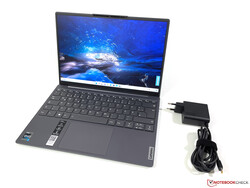
Lenovo ha aggiornato lo Yoga Slim 7i Carbon 13 ed è riuscita ancora una volta a mantenerlo leggermente al di sotto di 1 kg. Insieme a un caricabatterie leggero, il portatile ultraportatile può essere facilmente riposto nel bagaglio a mano quando si viaggia. Il dispositivo presenta uno chassis di alta qualità grazie all'utilizzo di materiali pregiati. Tuttavia, Lenovo ha rimosso una porta USB-C e il jack audio da 3,5 mm come parte della riprogettazione. Anche per quanto riguarda la tastiera si sono dovuti fare dei compromessi. Non è particolarmente buona a causa della breve corsa dei tasti. Inoltre, gli utenti non devono aspettarsi di essere sbalorditi dagli altoparlanti.
Ciononostante, siamo positivamente sorpresi dalle ottime prestazioni del processore Alder Lake-P. È in grado di fornire prestazioni molto buone anche se il processore è in grado di funzionare in modo ottimale. È in grado di funzionare molto bene anche sotto carico prolungato. Il portatile è inoltre dotato di caratteristiche moderne come Wi-Fi 6E, Thunderbolt 4, un veloce SSD PCIe 4.0 e sensori che aiutano a regolare automaticamente la luminosità dello schermo e della tastiera. Il pannello WQHD a 90 Hz è eccellente e presenta colori molto precisi fin dall'inizio.
Il nuovo Lenovo Yoga Slim 7i Carbon 13 offre uno chassis estremamente leggero e una grande quantità di prestazioni grazie al processore Alder Lake-P. Tuttavia, è stato necessario scendere a compromessi sulla tastiera e la combinazione di un Core i7 Alder Lake e di un pannello WQHD non è particolarmente efficiente.
Tuttavia, né il processore né lo schermo WQHD sono particolarmente efficienti. Di conseguenza, lo Yoga Slim 7i Carbon 13 rimane indietro rispetto alla maggior parte dei suoi concorrenti in termini di durata della batteria. Con un processore AMD, il Asus Zenbook S 13 è dotato di un SoC più efficiente. Pertanto, è in grado di offrire maggiori prestazioni della CPU multi-core e, soprattutto, migliori prestazioni della GPU, consumando meno energia. Il display OLED dello Zenbook offre anche una migliore qualità dell'immagine, secondo le nostre impressioni soggettive. Nonostante sia più sottile, il Apple MacBook Air M2 occupa un ingombro maggiore. Ciò detto, il MacBook è complessivamente superiore grazie al SoC veloce, al raffreddamento passivo, al display più luminoso e agli altoparlanti migliori.
Prezzo e disponibilità
Il nostro modello in prova è attualmente disponibile sul sito Lenovo per circa 1.500 euro (1.490 dollari). Se non vi dispiace avere un'unità SSD più piccola (512 GB), uno schermo con una frequenza di aggiornamento inferiore e una webcam senza privacy shutter, il modello Yoga Slim 7i Carbon 13 parte da soli 1.299 euro (1.300 dollari).
Lenovo Yoga Slim 7 Carbon 13IAP7-82U9005FGE
- 10/02/2022 v7 (old)
Andreas Osthoff




